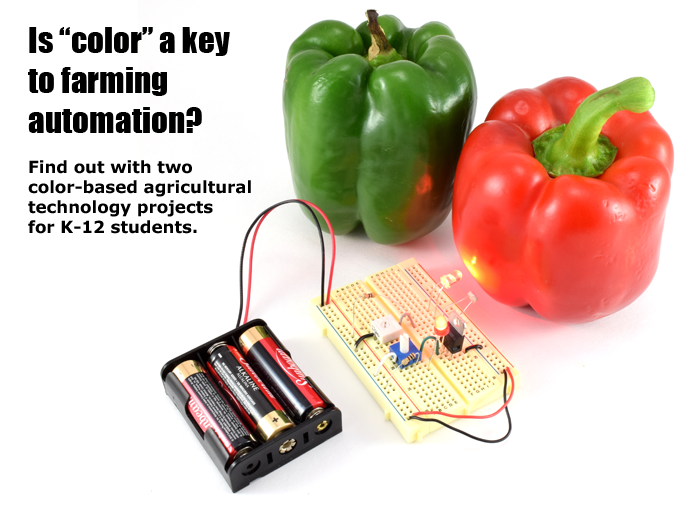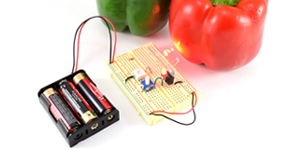The Color Code - Improving Agriculture with Color-smart Technology
As the world's population continues to grow, finding smarter and more sustainable ways to feed everyone is a global challenge. New solutions in agricultural technology may help. In two new agricultural technology projects, students explore color-based technologies that help students think about ways in which technology can be successfully applied to farming.

Billions to feed
With some growth projections suggesting there could be more than 9 billion mouths to feed by 2100, finding ways to ensure the availability of food for the world's population is a global imperative. To meet the growing need, farmers are racing to find new and sustainable ways to increase production, better and more effective ways to maximize yield. Historically, farming has relied on manual labor and processes, farmers riding farm equipment to prepare and tend fields and monitoring, sampling, and harvesting crops by hand. Today, farmers are adopting management styles that take advantage of technology solutions being designed for and applied to the unique needs and challenges of agriculture. In other words, today's agricultural landscape is increasingly high-tech.
Seeding technology solutions
Agricultural technology offers innovative ways to use computer systems to gather, analyze, and report on field and crop data, to help automate tasks, and to give farmers better information about individual crops. Many farmers are replacing traditional low-tech farming methods with high-tech, smart systems. These new tools apply computer science, robotics, and electronics to farm management tasks and have the potential to significantly impact a farmer's success.
Science Buddies is committed to helping students explore science, technology, engineering, and math (STEM) with real-world implications. Students interested in agriculture can get hands-on with projects that examine emerging technologies and can test, innovate, and evaluate ways that technology may be used to help address the world's food needs and improve agricultural processes and management. Two new high school student science project ideas encourage students to experiment with agricultural technology. In both of these projects, color plays a key role in a tech solution that may help farmers more efficiently tend and harvest fields and crops.
Is it ripe?
A new plant biology project idea from Science Buddies guides students in an exploration of electronics that could be used to help farmers assess fields or crops. In the Is It Ripe Yet? Build a Circuit to Detect Ripe Produce project, students build a circuit that can differentiate between the colors red and green. This kind of sensor-based circuit could have many agricultural uses. For example, farm equipment could be programmed to automatically tell which plants are ripe and which ones are not, resulting in smarter and more efficient harvesting. It may sound like science fiction to have robotic equipment harvest only the ripe strawberries in a crop, but in this project, students create the kind of circuit that might someday be used for exactly this purpose.
In this project, students build an electronic color-detecting circuit using a light-emitting diode (LED) and a photoresistor. By investigating how the photoresistor's resistance changes when you illuminate different color surfaces with a red LED, students create and fine-tune a circuit with an LED that lights up if the fruit or produce is ripe (red) and does not light up if the fruit is not ripe (green).
A bird's-eye view
In the new Smarter Farming with Aerial Photo Analysis environmental science project idea from Science Buddies, students investigate what can be determined from looking at the color histograms of a photo. After comparing histograms to see how colors (like green and brown) can be quantitatively differentiated, students write up a set of steps that could be repeated by a computer (e.g., an algorithm) to evaluate a photo and determine how "green" the photo is. After first testing with construction paper, students then test (and adjust) their algorithm to see how well it work with aerial photos of grassy (green) and non-grassy land (brown).
If successful, this kind of computer analysis of aerial (bird's-eye) photos of an area might someday help farmers make decisions about field health and treatment for individual fields or even areas of a field, rather than treating all fields based on small data samples.
Learn more about agricultural technology
The new Agricultural Technology Science Projects page is a special interest collection of student science, technology, engineering, and math projects and resources, including related careers.
Categories:
You Might Also Enjoy These Related Posts:
- Plastics and Earth Day - Science Projects
- Arduino Science Projects and Physical Computing
- 10+ Robotics Projects with the BlueBot Kit
- 5 STEM Activities with Marshmallow Peeps
- March Madness Basketball Science Projects: Sports Science Experiments
- Women in STEM! More than 60 Scientists and Engineers for Women's History Month
- Explore Artificial Intelligence and Machine Learning with Student AI Projects
- 10 Reasons to Do the Rubber Band Car Engineering Challenge










